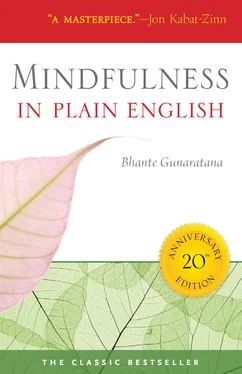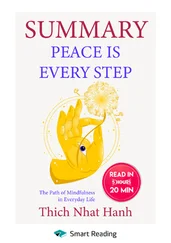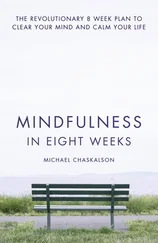Henepola Gunaratana - Mindfulness in Plain English
Здесь есть возможность читать онлайн «Henepola Gunaratana - Mindfulness in Plain English» весь текст электронной книги совершенно бесплатно (целиком полную версию без сокращений). В некоторых случаях можно слушать аудио, скачать через торрент в формате fb2 и присутствует краткое содержание. Жанр: Самосовершенствование, на английском языке. Описание произведения, (предисловие) а так же отзывы посетителей доступны на портале библиотеки ЛибКат.
- Название:Mindfulness in Plain English
- Автор:
- Жанр:
- Год:неизвестен
- ISBN:нет данных
- Рейтинг книги:3 / 5. Голосов: 1
-
Избранное:Добавить в избранное
- Отзывы:
-
Ваша оценка:
- 60
- 1
- 2
- 3
- 4
- 5
Mindfulness in Plain English: краткое содержание, описание и аннотация
Предлагаем к чтению аннотацию, описание, краткое содержание или предисловие (зависит от того, что написал сам автор книги «Mindfulness in Plain English»). Если вы не нашли необходимую информацию о книге — напишите в комментариях, мы постараемся отыскать её.
Mindfulness in Plain English — читать онлайн бесплатно полную книгу (весь текст) целиком
Ниже представлен текст книги, разбитый по страницам. Система сохранения места последней прочитанной страницы, позволяет с удобством читать онлайн бесплатно книгу «Mindfulness in Plain English», без необходимости каждый раз заново искать на чём Вы остановились. Поставьте закладку, и сможете в любой момент перейти на страницу, на которой закончили чтение.
Интервал:
Закладка:
It certainly looks that way. There sits the meditator parked on his little cushion. Is he out giving blood? No. Is he busy working with disaster victims? No. But let us examine his motivation. Why is he doing this? His intention is to purge his own mind of anger, prejudice and ill-will. He is actively engaged in the process of getting rid of greed, tension and insensitivity. Those are the very items which obstruct his compassion for others. Until they are gone, any good works that he does are likely to be just an extension of his own ego and of no real help in the long run. Harm in the name of help is one of the oldest games. The grand inquisitor of the Spanish Inquisition spouts the loftiest of motives. The Salem witchcraft trials were conducted for the public good. Examine the personal lives of advanced meditators and you will often find them engaged in humanitarian service. You will seldom find them as crusading missionaries who are willing to sacrifice certain individuals for the sake of some pious idea. The fact is we are more selfish than we know. The ego has a way of turning the loftiest activities into trash if it is allowed free range. Through meditation we become aware of ourselves exactly as we are, by waking up to the numerous subtle ways that we manifest our own selfishness. Then we truly begin to be genuinely selfless. Cleansing yourself of selfishness is not a selfish activity.
Wrong again. There are certain systems of contemplation in which this sort of thing is done. But that is not Vipassana. Vipassana is the practice of awareness. Awareness of whatever is there, be it supreme truth or crummy trash. What is there is there. Of course, lofty aesthetic thoughts may arise during your practice. They are certainly not to be avoided. Neither are they to be sought. They are just pleasant side-effects. Vipassana is a simple practice. It consists of experiencing your own life events directly, without preference and without mental images pasted to them. Vipassana is seeing your life unfold from moment to moment without biases. What comes up comes up. It is very simple.
Sorry, meditation is not a quick cure-all. You will start seeing changes right away, but really profound effects are years down the line. That is just the way the universe is constructed. Nothing worthwhile is achieved overnight. Meditation is tough in some respects. It requires a long discipline and sometimes a painful process of practice. At each sitting you gain some results, but those results are often very subtle. They occur deep within the mind, only to manifest much later, and if you are sitting there constantly looking for some huge instantaneous changes, you will miss the subtle shifts altogether. You will get discouraged, give up and swear that no such changes will ever occur. Patience is the key. Patience. If you learn nothing else from meditation, you will learn patience. And that is the most valuable lesson available.
Chapter 3
What Meditation Is
Meditation is a word, and words are used in different ways by different speakers. This may seem like a trivial point, but it is not. It is quite important to distinguish exactly what a particular speaker means by the words he uses. Every culture on earth, for example, has produced some sort of mental practice which might be termed meditation. It all depends on how loose a definition you give to that word. Everybody does it, from Africans to Eskimos. The techniques are enormously varied, and we will make no attempt to survey them. There are other books for that. For the purpose of this volume, we will restrict our discussion to those practices best known to Western audiences and most likely associated with the term meditation.
Within the Judeo-Christian tradition we find two overlapping practices called prayer and contemplation. Prayer is a direct address to some spiritual entity. Contemplation is a prolonged period of conscious thought about some specific topic, usually a religious ideal or scriptural passage. From the standpoint of mental culture, both of these activities are exercises in concentration. The normal deluge of conscious thought is restricted, and the mind is brought to one conscious area of operation. The results are those you find in any concentrative practice: deep calm, a physiological slowing of the metabolism and a sense of peace and well-being.
Out of the Hindu tradition comes Yogic meditation, which is also purely concentrative. The traditional basic exercises consist of focusing the mind on a single object—a stone, a candle flame, a syllable or whatever, and not allowing it to wander. Having acquired the basic skill, the Yogi proceeds to expand his practice by taking on more complex objects of meditation chants, colorful religious images, energy channels in the body and so forth. Still, no matter how complex the object of meditation, the meditation itself remains purely an exercise in concentration.
Within the Buddhist tradition, concentration is also highly valued. But a new element is added and more highly stressed. That element is awareness. All Buddhist meditation aims at the development of awareness, using concentration as a tool. The Buddhist tradition is very wide, however, and there are several diverse routes to this goal. Zen meditation uses two separate tacks. The first is the direct plunge into awareness by sheer force of will. You sit down and you just sit, meaning that you toss out of your mind everything except pure awareness of sitting. This sounds very simple. It is not. A brief trial will demonstrate just how difficult it really is. The second Zen approach used in the Rinzai school is that of tricking the mind out of conscious thought and into pure awareness. This is done by giving the student an unsolvable riddle which he must solve anyway, and by placing him in a horrendous training situation. Since he cannot flee from the pain of the situation, he must flee into a pure experience of the moment. There is nowhere else to go. Zen is tough. It is effective for many people, but it is really tough.
Another stratagem, Tantric Buddhism, is nearly the reverse. Conscious thought, at least the way we usually do it, is the manifestation of ego, the you that you usually think that you are. Conscious thought is tightly connected with self-concept. The self-concept or ego is nothing more than a set of reactions and mental images which are artificially pasted to the flowing process of pure awareness. Tantra seeks to obtain pure awareness by destroying this ego image. This is accomplished by a process of visualization. The student is given a particular religious image to meditate upon, for example, one of the deities from the Tantric pantheon. He does this in so thorough a fashion that he becomes that entity. He takes off his own identity and puts on another. This takes a while, as you might imagine, but it works. During the process, he is able to watch the way that the ego is constructed and put in place. He comes to recognize the arbitrary nature of all egos, including his own, and he escapes from bondage to the ego. He is left in a state where he may have an ego if he so chooses, either his own or whichever other he might wish, or he can do without one. Result: pure awareness. Tantra is not exactly a game of patty cake either.
Vipassana is the oldest of Buddhist meditation practices. The method comes directly from the Sitipatthana Sutta, a discourse attributed to Buddha himself. Vipassana is a direct and gradual cultivation of mindfulness or awareness. It proceeds piece by piece over a period of years. The student’s attention is carefully directed to an intense examination of certain aspects of his own existence. The meditator is trained to notice more and more of his own flowing life experience. Vipassana is a gentle technique. But it also is very, very thorough. It is an ancient and codified system of sensitivity training, a set of exercises dedicated to becoming more and more receptive to your own life experience. It is attentive listening, total seeing and careful testing. We learn to smell acutely, to touch fully and really pay attention to what we feel. We learn to listen to our own thoughts without being caught up in them.
Читать дальшеИнтервал:
Закладка:
Похожие книги на «Mindfulness in Plain English»
Представляем Вашему вниманию похожие книги на «Mindfulness in Plain English» списком для выбора. Мы отобрали схожую по названию и смыслу литературу в надежде предоставить читателям больше вариантов отыскать новые, интересные, ещё непрочитанные произведения.
Обсуждение, отзывы о книге «Mindfulness in Plain English» и просто собственные мнения читателей. Оставьте ваши комментарии, напишите, что Вы думаете о произведении, его смысле или главных героях. Укажите что конкретно понравилось, а что нет, и почему Вы так считаете.












